Original URL: https://www.theregister.com/2014/04/08/next_television_curved_screen/
Bendy or barmy: Why your next TV will be curved
That's some time during a 10-year refresh cycle, though
Posted in Legal, 8th April 2014 09:00 GMT
Feature For a while it looked like the future of television was fairly clear-cut. Full HD would beget 4K Ultra HD and at some point in the future, presumably when we all owned flying cars and had relatives commuting to Mars, that would evolve into 8K Super Hi-Vision.
Apart from trifling things like resolution, colour gamut and frame rates, nothing much else would change. And then something strange happened. Screens began to curve.
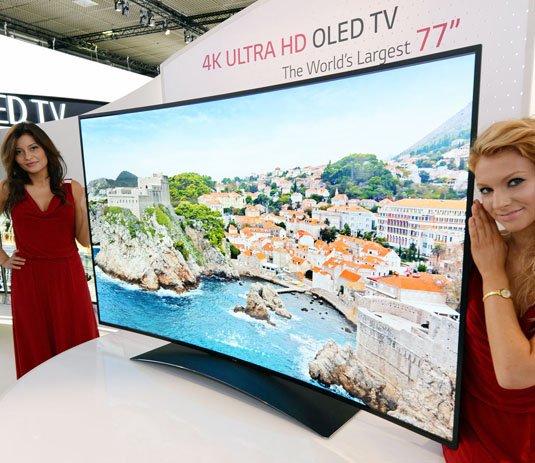
LG’s curved curiosity from IFA 2013 – the “largest” 77-incher at the time
When the first curved panels appeared they seemed little more than curiosities, a symptom of engineering brinkmanship between arch rivals LG and Samsung. Significantly, they involved OLED, the notoriously difficult to manufacture but super-thin display technology.
As Thomas Lee, LG’s VP of Home Entertainment, confided to me last year: “There's a lot of research and development going into curved screens. They’re more comfortable to watch and give you a really immersive viewing experience.” Curves, it seemed, were being fast-tracked to distinguish OLED panels from existing TV tech.
Then both South Korean manufacturers solved the conundrum of bending an LED backlit LCD screen, and the curve went from idiosyncrasy to ideology.
Fast-forward to Samsung’s recent European product forum, where the brand unveiled its entire portfolio to Euro dealers. Heading its TV range were curved 4K screens in 55-, 65- and 78-inch screen sizes.
President and CEO BK Yoon was unequivocal: “2014 will be the year of curved Ultra High Definition TV,” he pronounced. While the brand will also offer the conventional HU7500 line, all flat 4K screens are locked to 2013 picture processing technology. It’s clear where the R&D is going.
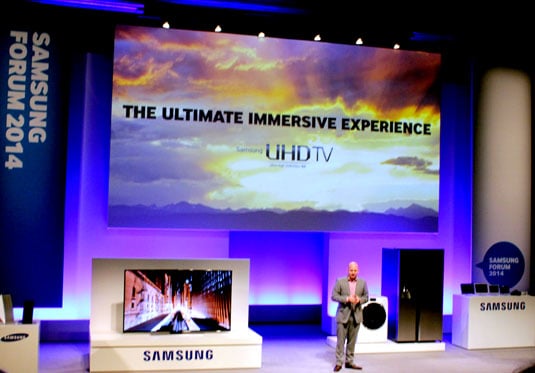
Points on the curve: Michael Zoeller, Samsung European sales head honcho takes the forum stand
Sales predictions are probably way too bullish though. Samsung’s incoming European chief executive Sunny Lee said the UHD TV market was set to “explode,” growing 1,300 per cent in 2014. By 2017, he predicted annual European shipments of UHD TVs to hit 3.3 million units. This might be somewhat ambitious in the light of recent sales figures.
Art nouveau
Michael Zoeller, Samsung’s European sales and marketing topper, made it clear that his brand was on a mission change the shape of television. Having made design as important to buyers as image quality, he was confident that the time was right to make 4K UHD synonymous with curves. “There’s a lot of research out there that says the human eye is naturally drawn to strong curves,” he argued. “Our curved TVs aren’t just beautiful, they’re works of art!”
He’s not wrong on either count. Curves always attract (insert joke here) and the new Samsung 4K fleet is undeniably beautiful of form. But are there actually any technical reasons why a curved TV should provide fundamentally superior viewing experience than a flat one?
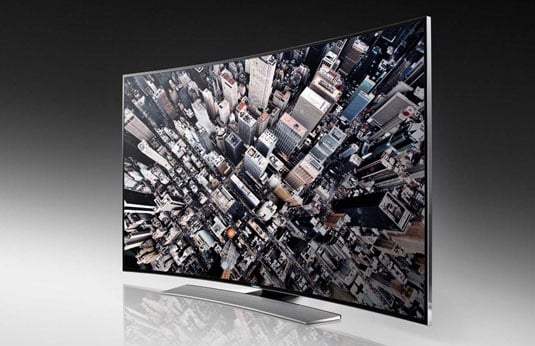
Home cinema? Samsung's U8500 105-inch curved TV features a 21:9 aspect ratio
Much is made of their cinematic aesthetic. There are good practical reasons why movie screens curl. Curved screen fabric offers better brightness uniformity and reduces pincushion distortion caused by the throw distance of the projector; light strikes the entire surface at the same time. This isn’t applicable to TVs, although there is a vaguely comparable benefit.
LED LCD TVs tend to lose colour and contrast when viewed off angle. When the edges of the curved set actually angle in to the viewer, this doesn’t happen – colours remain vibrant and contrast stays high. Conversely, move out of the viewing sweet spot when watching a curved screen and somewhat different visual anomalies become apparent.
The portion on the closest edge appears to subtly distort. Sit well off to the edge (y’know, where you park grandma), and the physical edge of the screen begins to make itself noticeable in a way that doesn’t happen with a flatscreen.
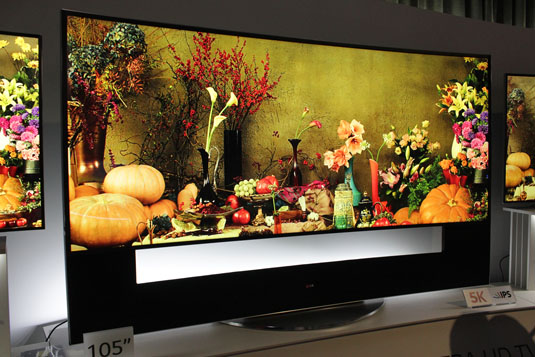
LG's 105UC9 Cinemascope ratio 105-inch curved OLED TV
“The curve is about more than design,” insists Kinnell. “The curve provides a wider field of view and a panoramic effect that makes the set seem bigger than it is. When an object moves on a curved screen, it’s more realistic.”
What’s certain is that when you sit in the sweet spot (and there is a clear sweet spot with curved TVs), you’re definitely aware of a wraparound visual effect. This creates an immersive intensity that you don’t get with a flatscreen. A native 4K demo sequence of a POV valley fly-though actually left me a tad dizzy. Not ideal when watching Top Gear, but I suspect playing PS4 on one of these screens is going to be a blast.
Depth gauge
Samsung’s engineers have developed a picture processor specifically to enhance the image on curved panels. Called an Auto Depth Enhancer, it creates greater contrast and layered depth. A bit like 3D without the funny goggles.
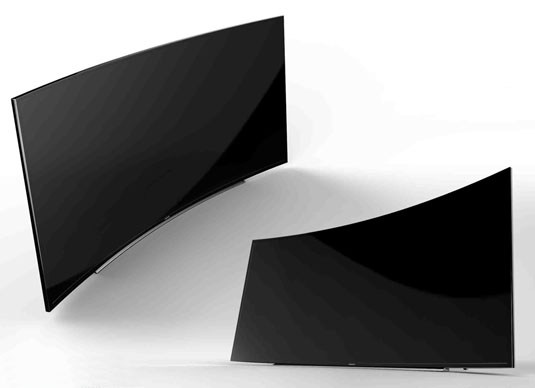
Keep it sweet: just like 3D TVs, the fixed curved panel sets have an ideal viewing position
The sweet spot also makes curved viewing a strangely singular experience, particularly on smaller screens. The most impressive experience is to be had on the largest models, typically from 78-inches upwards. A 105-inch 21:9 5K (5120 x 2160) curved prototype wears its curvature spectacularly well. The sheer size allows for more accommodating viewing – the sweet spot widens dramatically – while that Cinemascope aspect ratio is damn impressive.
Interestingly, as you view further back (3 to 4 metres), the curve begins to diminish to the point where it’s barely noticeable. The image flattens and the sweet spot ceases to be a factor. Of course, at that distance you’re not really getting the benefit of those extra UHD pixels on a 55-inch screen either.
Not every manufacturer seems as committed to a curved future as Samsung or LG. Japanese brands are keeping the faith with flatscreens, at least for 2014, although Panasonic did show both concave and convex OLED panels at CES, not least to prove it could make them if it really wanted.
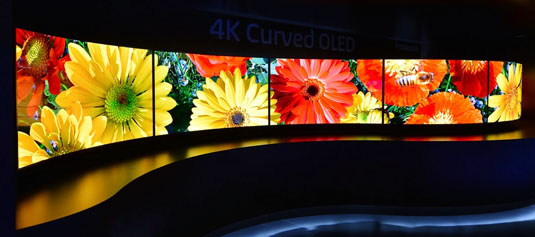
Panasonic gives in to the bends with a wave curved 55-inch OLED TVs at CES
But this flat intransigence may not last. The market dominance of Samsung and LG could be enough to convince others to pitch in for fear of losing valuable share. If affluent fashionistas warm to the new form factor, the 4K playground could warp rapidly.
While Samsung’s curved strategy is focused on its HU8500 4K screens, it’s also launching a Full HD H8000 range of curved models.
Flexible trend
Inevitably, having mastered how to bend flatpanels, the boffins from both LG and Samsung have now developed flexible tech to straighten them back up again. Both companies have shown prototype screens allow you to adjust the angle of the curve via remote control. The technical solutions differ slightly between Samsung and LG (the former uses some sort of concertina-approach while the latter employs a hinged rear) but the end result is much the same. As an example of unapologetic over-engineering, they’re hard to beat.
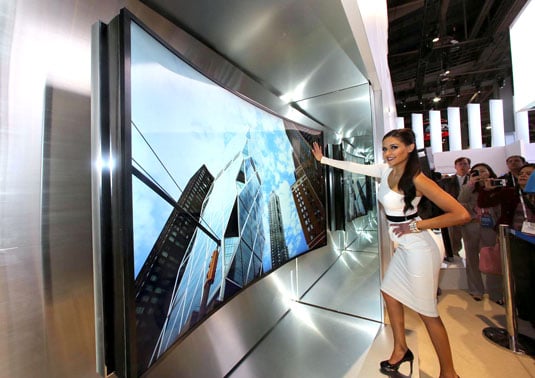
Bend it like Samsung: curved TV with a difference, it’s flexible
Neither brand has offered much of a reason why consumers would want to pay a premium for the privilege of flexing curved televisions, although there may be some benefit in being able to control reflections or broaden the viewing position. At the Samsung EU forum, Guy Kinnell did suggest that if consumers really wanted a flat 4K UHD TV in the future, they could always buy a flexi-model and flatten it up. He may have been joking.
It remains to be seen if these new look TVs will win over the tech cognoscenti. Geoff Meads is lead instructor for CEDIA, the trade organisation which fosters and trains the custom install industry, purveyors of high-end home theatres and the like. He’s far from convinced.
Downward curve?
“I'm currently filing curved flat panels in the same place I put 21:9 and 3D flat panel TVs, in the big box marked 'solutions looking for a problem',” he said. “Unless you plan on sitting incredibly close to the screen, or watch very wide aspect material, neither of which are likely on a domestic TV, there is simply no justification for the curve. Add in the fact that they won't sit flat on the wall and are almost certain to cause viewing 'sweet spots' and you've got a non-starter.”
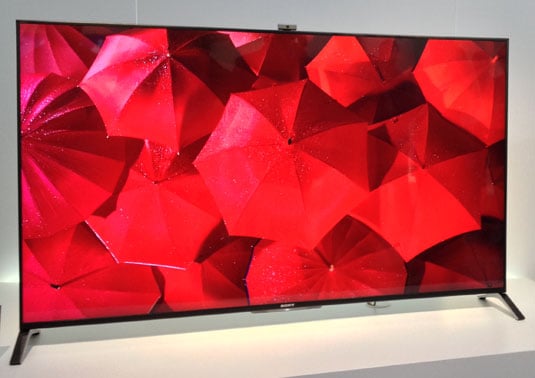
Sony plays it straight with the X85 65-inch flat panel 4K TV
4K fanciers now face a conundrum: join Samsung and LG and buy into UHD as a curved display format, or back a flattie. If Samsung is right and curved 4K really does transpire to be the future, then the rest of the market will flip quickly.
Buying early could actually be the best option if you want to stay on the straight and narrow. Falter and you could be left trawling eBay for your next TV upgrade in a few years from now. There again, the market might actually transpire to be limited to Oast houses and flat will be back in vogue. The TV business is suddenly getting really interesting again. ®